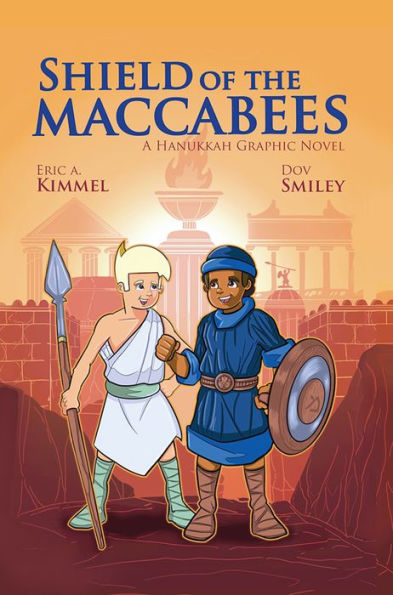"All history books," Dara Horn has written, "fact or fiction, are really about the times in which they are written, not about the times they supposedly describe." This is particularly true when it comes to historical fiction, and it's very true about Shield of the Maccabees, Eric Kimmel and Dov Smiley's graphic novel about a friendship between a Greek boy and a Jewish boy that is fractured by the conflict between the Greeks and the Jewish Maccabees.
Kimmel uses this framework to tell a story about friendship transcending differences — a story that should appeal greatly to its intended modern-day audience, although the main message might have made little sense to its historical characters.
Its main point aside, this vivid, fast-moving book includes plenty of authentic and well-researched historical facts. Greek myths, sports, and methods of teaching are all brought into the boys' story and relationship. Jonathan and Jason are both well-drawn, relatable characters, brought to life by fun, exciting drawings. The author builds up both their friendship and the roots of the conflict before the story gets serious; once it does, the horrors of war are also touched upon in an age-appropriate and non-graphic way.
This book meets the criteria for consideration for a Sydney Taylor Book Award; it is essentially a modern Jewish retelling of an ancient Jewish story, and modern American-Jewish children will both enjoy the book and learn from it.
—Leah Cypess, The Sydney Taylor Schmooze
Children’s books about the historical and religious origins of Hanukkah often emphasize the heroism of the Maccabees. In 167 B.C.E., these Judean freedom fighters were committed to opposing both a repressive Greek regime and the assimilationist strategies adopted by many of their fellow Jews. The joyous winter holiday of Hanukkah celebrates both the military victory and the miraculous small jar of oil found in the desecrated Temple, which allowed the menorah lights to last for eight days. Eric Kimmel and Dov Smiley have chosen a more nuanced approach in their new graphic novel, emphasizing the validity of both Jewish and Greek culture and the tragedy of war for both peoples. The Jewish rebels are still brave defenders of their right to religious freedom and national self-determination but the novel also depicts the terrible price of intolerance. The close friendship of Jason and Jonathan, a Greek and a Jewish boy, is the lens through which Kimmel and Smiley view this truth.
An ancient setting and a contemporary tone tell Jason and Jonathan’s story. Jews and Greeks appear ethnically different; Jonathan is olive-skinned while Jason is improbably pale and blond. (The author takes some historical liberties, some of which are clarified in the book’s back matter.) While in reality, a young Jew would not have attended school with his Greek friend, thanks to a conveniently tolerant teacher, Jason is allowed to invite his friend to classes about the Socratic method and Homer’s Odyssey. Jonathan’s family warmly welcomes Jason to their Shabbat dinner and Purim celebration. The friends have many conversations about their competing belief systems, which are mutually respectful and preternaturally mature. (Jonathan: “But why do you need so many Gods? Jason: I think it’s because people have different needs at different times.”). Not every moment of their time together involves philosophy; there is also plenty of discus throwing and fishing.
Then a change of leadership threatens the relative coexistence in their Hellenistic kingdom. Antiochus IV is presented as a wounded bully with an ugly and infantile personality. Angered by his recent military defeats he blames the Jews and reverses previous policies which had allowed them a degree of autonomy. The gentle tone of the narrative becomes full of tension and fear, as soldiers serving their tyrannical leader confront Jewish guerrilla fighters with uncompromising tactics. Kimmel is careful to preserve the idealism of the Maccabees while also showing the chaos of war, as Jason and Jonathan become caught up in terrifying circumstances beyond their control. Smiley’s familiar comic book images of boyhood friendship become converted to darker scenes hatred and combat.
In his “Author’s Note,” Kimmel explains both the historical background of multicultural Judea, and his own idealism in giving young readers a hopeful story of two courageous individuals who embody the best of their own traditions. Jason and Jonathan’s quest can be as much a part of Hanukkah tradition as Jewish victory over Greek despots and their collaborators.
—Emily Schneider, Jewish Book Council
2021-08-31
A Greek boy and a Judean boy become unlikely friends at the time of the Hanukkah story.
In Jason and Jonathan’s Judea, the Greek colonizers and the Jews they rule over live in a somewhat troubled peace. They go to different schools and speak different languages, but people are allowed to live and worship as they please. Nonetheless, many Judeans (mostly illustrated with brown or olive skin and dark hair) resent the Greeks (mostly light-skinned, many with pale yellow hair). In this fraught balance, Jonathan and Jason bond over the important things in life: teaching each other slick wrestling moves, playing discus, and discussing the nature of the divine. Jonathan accompanies Jason to Greek school, while Jason joins Jonathan’s family for (somewhat anachronistic) religious celebrations. But their fragile friendship comes to an end when wicked King Antiochus blames the Jews for his own troubles. The boys are pulled into the bloody war that paves the way for the Maccabean victory and the Hanukkah miracle. An author’s note speaks to the aim of reaching for the real history behind the tropes of this most widely known Jewish holiday, but the tale still owes vastly more to myth than to history. The clunky, oddly proportioned comics panels, with blocky but movement-filled composition, don’t complement the philosophical narrative.
Stick with Kimmel’s many other, vastly superior, Hanukkah books. (historical note) (Graphic historical fiction. 7-9)



